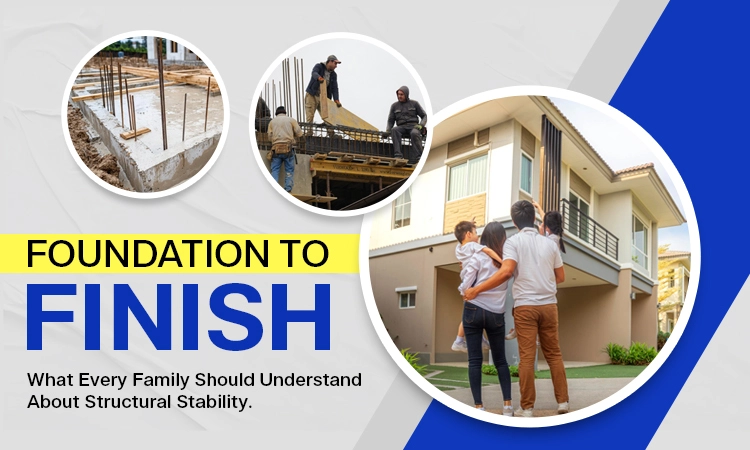
Foundation to Finish: What Every Family Should Understand About Structural Stability
Families often prefer interior design, aesthetics, or bedroom numbers when planning a home. Even though these elements are important, structural stability should never be ignored. A home is a system that depends on a strong foundation, high-quality materials, and regular maintenance to stay safe, durable, and comfortable over time. It is made of more than just walls, ceilings, and floors. Every homeowner needs to understand the importance of structural stability, whether a new home is built, undergoing structural repair, or renovating an existing one.
Why Structural Stability Matters
Structural stability is the ability of a building to withstand natural wear and tear as well as external forces like gravity, wind, temperature variations, or even minor seismic activity without failing. Making sure the foundation, walls, beams, and roof all function as one complete unit to provide a safe, durable environment for families is more important than just keeping the walls upright.
Early warning signs often show up in an unstable home. Hairline cracks on walls, uneven flooring, or doors that suddenly stop fitting their frames could be the beginning signs. These could appear to be small cosmetic problems, but they may be signs of more serious structural issues. Ignoring these problems can eventually result in compromised safety, expensive repairs, and even a drop in your property’s selling value.
Benefits of prioritizing stability:
- Safety: Protects against accidents brought on by structural flaws.
- Durability: Ensures a longer lifespan for the home with less maintenance.
- Savings: Reduces the need for costly structural repairs and other major fixes.
For instance, if a small foundation crack gets ignored today, it could eventually require major structural repair.
Foundations: The Backbone of Your Home
The foundation serves as the backbone of the entire house and is more than just the concrete that lies beneath the ground. Its primary role is to maintain the building’s stability, distribute loads evenly, and resist environmental stress. A well-designed foundation ensures that the home remains safe, level, and functional even if the soil underneath moves or sinks.
No two building sites are alike, and each home is built on a unique type of soil. While some soils are soft and prone to shrinking or expanding based on moisture content, others are firm and rocky. For this reason, before construction begins, engineers carefully evaluate the type of soil.
Warning signs of foundation issues include:
- Doors that stick or uneven flooring.
- Cracks close to windows, ceilings or corners.
- Gaps between ceilings and walls.
Costly problems later on can be prevented with early inspection and maintenance.
Framing and Load-Bearing Components
Framing is the next critical stage in construction after the foundation is complete. Framing is the house’s skeleton, if the foundation is its backbone. In order to support the building’s load and resist external forces like wind, storms, and even minor seismic activity, it includes the roof structure, walls, beams and columns.
Weight distribution, room alignment, and the house’s long-term safety and durability are all ensured by a well-designed frame. On the other hand, poorly done framing can lead to visible issues like uneven floors, sagging ceilings, and wall cracks—and in severe cases, compromise the entire structure.
Key points for strong framing:
- Material Quality: Durable steel, concrete, and wood provide long-lasting support.
- Accurate Design: Stress spots that may weaken the structure are prevented by proper alignment.
- Load Awareness: It’s important to know which walls can support load, especially when renovating or making modifications to the interior design.
For instance, removing a load-bearing wall without reinforcement can result in more serious damage, such as sagging ceilings.
Role of Professional Design and Execution
In addition to being functional, the floors and roof also add to the structural stability. Floors distribute weight equally throughout the structure, while roofs shield the interior from the sun, wind and rain.
Common issues that impact stability:
- Water leaks erode floor joists or beams.
- Poorly constructed floors that are uneven or sagging.
Regular maintenance prevents minor issues from turning into more serious structural repairs.
Maintenance: A Proactive Approach
For even well-built homes to remain structurally sound, regular inspections are necessary.
Homeowners need to look for:
- Cracks in the ceiling or walls.
- Roofs, bathrooms, and kitchens have water leaks.
- Timber structures damaged by termites or other pests.
Early fixing of problems maintains the home’s structural integrity, prevents costly repairs, and maintains its visual appeal.
Example: Fixing a small leak quickly can prevent rot that might otherwise require beam replacement.
Renovations and Interior Design: Plan Carefully
Some structural issues are subtle and need evaluation by experts.
The following situations require professional intervention:
- Major tilting or cracks in the foundation.
- Persistent water damage to walls or beams.
- Uneven floors or a sagging roof.
Every aspect of a home, from foundation to roof, is impacted by structural stability. Families who value stability in addition to style and functionality have homes that are safer and last longer.

 Get an expert-reviewed estimate tailored to your project, location, and budget. Share your details for an accurate construction or renovation cost.
Get an expert-reviewed estimate tailored to your project, location, and budget. Share your details for an accurate construction or renovation cost.